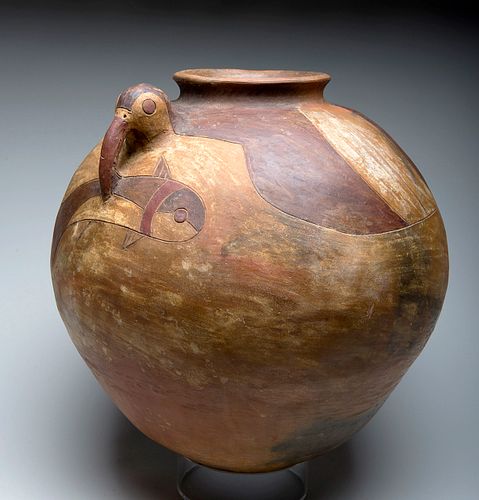Huge Paracas Bi-Chrome Olla, Cormorant Catching Fish
Lot 106e
About Seller
Artemis Fine Arts
686 S Taylor Ave, Ste 106
Louisville, CO 80027
United States
Selling antiquities, ancient and ethnographic art online since 1993, Artemis Gallery specializes in Classical Antiquities (Egyptian, Greek, Roman, Near Eastern), Asian, Pre-Columbian, African / Tribal / Oceanographic art. Our extensive inventory includes pottery, stone, metal, wood, glass and textil...Read more
Categories
Estimate:
$16,000 - $24,000
Absentee vs Live bid
Two ways to bid:
- Leave a max absentee bid and the platform will bid on your behalf up to your maximum bid during the live auction.
- Bid live during the auction and your bids will be submitted real-time to the auctioneer.
Bid Increments
| Price | Bid Increment |
|---|---|
| $0 | $25 |
| $300 | $50 |
| $1,000 | $100 |
| $2,000 | $250 |
| $5,000 | $500 |
| $10,000 | $1,000 |
| $20,000 | $2,500 |
| $50,000 | $5,000 |
| $100,000 | $10,000 |
| $200,000 | $20,000 |
About Auction
By Artemis Fine Arts
Feb 13, 2020
Set Reminder
2020-02-13 10:00:00
2020-02-13 10:00:00
America/New_York
Bidsquare
Bidsquare : Exceptional Antiquities, Asian, Ethnographic
https://www.bidsquare.com/auctions/artemis-gallery/exceptional-antiquities-asian-ethnographic-4848
An important one-day auction featuring museum-worthy examples of Egyptian, Greek, Roman, Etruscan, Near Eastern, Far East / Asian, Pre-Columbian, African / Tribal, Oceanic, Native American, Spanish Colonial, Russian, Fossils, Ancient Jewelry, Fine Art, so much more! Artemis Fine Arts info@artemisfinearts.com
An important one-day auction featuring museum-worthy examples of Egyptian, Greek, Roman, Etruscan, Near Eastern, Far East / Asian, Pre-Columbian, African / Tribal, Oceanic, Native American, Spanish Colonial, Russian, Fossils, Ancient Jewelry, Fine Art, so much more! Artemis Fine Arts info@artemisfinearts.com
- Lot Description
Pre-Columbian, Peru, Paracas culture, ca. 500 to 100 BCE. Wow! A huge olla, carefully hand-modeled from terracotta, featuring the three-dimensional head of a cormorant on its shoulder. Clenched in its beak, incised and painted onto the broad body of the vessel, is a fish with an expressionless face despite its predicament. The bird's massive spread wings are also incised and painted around the shoulder, with a tab-like projecting tail feather on the opposite side of the vessel from the bird's head. Both bird and fish have round, red eyes, creamy brown lower bodies, and very dark red upper bodies. A delicate mouth with short, projecting spout and slightly rolled rim completes the vessel, which stands on a diminutive, flat base that was probably made to be pressed into sandy earth to steady it. Size: 16" W x 16" H (40.6 cm x 40.6 cm)
On pottery, textiles, and other materials, the Paracas people depicted three types of animals over and over again: felines, serpents, and birds. Their bird depictions are varied and rich, probably reflecting the many birds native to their homeland on the southern coast of Peru. Paracas artists emphasized the more fearsome aspects of all the animals they depicted, as here the long, sharp beak takes precedence. Birds often accompany trophy head art, and there are "bird impersonators", human figures with bird aspects, who often appear on Paracas textiles, suggesting a tradition of performance where humans were dressed as birds. This oftentimes involved the use of hallucinogenic drugs to enter a spiritual state where shamans could become one with birds and other animals.
Provenance: ex-private Hans Juergen Westermann collection, Germany, collected from 1950s to 1960s
All items legal to buy/sell under U.S. Statute covering cultural patrimony Code 2600, CHAPTER 14, and are guaranteed to be as described or your money back.
A Certificate of Authenticity will accompany all winning bids.
We ship worldwide and handle all shipping in-house for your convenience.
#153296Expertly repaired and restored from multiple pieces; this is well done and difficult to discern. Most of the original pigment remains with light deposits and firing marks visible on the surface. Excellent form and detail.Condition
- Shipping Info
-
All shipping is handled in-house for your convenience. Your invoice from Artemis Gallery will include shipping calculation instructions. If in doubt, please inquire BEFORE bidding for estimated shipping costs for individual items.
-
- Buyer's Premium



 EUR
EUR CAD
CAD AUD
AUD GBP
GBP MXN
MXN HKD
HKD CNY
CNY MYR
MYR SEK
SEK SGD
SGD CHF
CHF THB
THB















